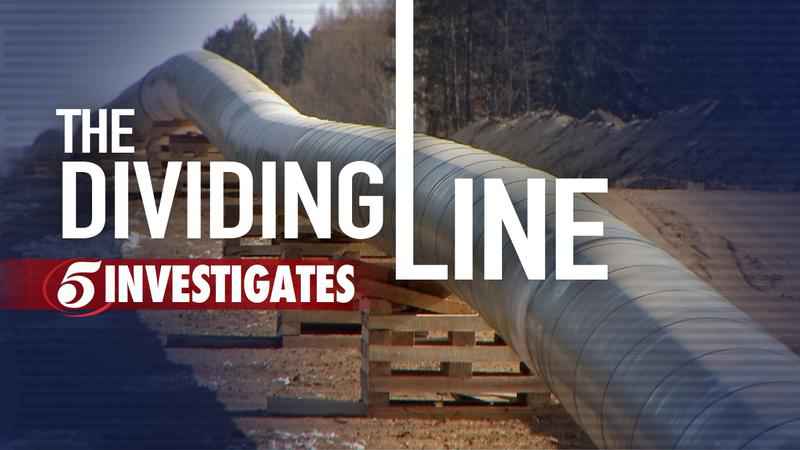Activists continue fight to stop Line 3 as police agencies team up quell unrest
[anvplayer video=”5013182″ station=”998122″]
Activists energized by the recent halting of the Keystone XL oil pipeline out west remain more motivated than ever to try and stop a controversial pipeline project from moving forward in northern Minnesota.
In the three months since Enbridge received final approval to begin building its Line 3 oil pipeline, construction has been disrupted several times by protestors who have climbed into pipes, locked themselves to equipment, or jumped into trenches.
The protestors often film themselves in the act and share it on social media in an effort to drum up more support for their cause.
“I think it’s important for folks to understand what we’re trying to protect,” said Tara Houska, one of the organizers of the so-called water-protectors, a group of mostly Indigenous people trying to stop the pipeline.
The group is typically met by an organized show of force made up of several law enforcement agencies that have been preparing for this moment for years.

[KSTP]
“There’s a lot of groups that are for this and there’s a lot of groups that are against it. In my world, I get to stand right in the middle of all that energy,” Aitkin County Sheriff Dan Guida said.
Line 3 will pump about 800,000 barrels of oil every day from Alberta, Canada, to Superior, Wisconsin.
Unlike the Keystone XL project, Line 3 will replace an old line from the 1960s. A spokesperson for Canadian-based Enbridge said it worked with two tribes throughout the entire process to map out the best route, and it says the actual construction will help create hundreds of jobs.
The project was repeatedly delayed over the course of several years by court challenges and lengthy regulatory reviews.
As part of the approval process, the oil company was required to set up a special fund to reimburse law enforcement agencies, whose officers are frequently called on to stop unlawful demonstrations.
To streamline and better coordinate response efforts along Line 3, Sheriff Guida worked with police agencies in 17 other counties to form the Northern Lights Task Force. While the task force mostly monitors peaceful protesters, officers have been called in several times to stop trespassers who have engaged in more serious and illegal demonstrations.
Related stories:
2 Line 3 protesters arrested for blocking traffic in St. Louis County
Protesters stage sit-in inside northern Minnesota Line 3 pipeline segment
When protestors lock themselves to heavy construction equipment or jump into the pipeline trenches, the task force turns to a special field force extrication team.
“This team that we have, basically takes about two hours from the time we call them until the time they’re on scene with a trailer load of equipment to help extricate people off a pipe or out of a sleeping dragon or off of a piece of equipment,” Guida said.
The task force started planning years ago, in part because of what unfolded at the Dakota Access Pipeline in the fall of 2016.
Law enforcement monitoring the large encampment became overwhelmed and outnumbered at the Standing Rock Indian Reservation. They eventually turned to water canons, pepper spray and other means of less-lethal force to disperse the crowds.
More than 300 people were injured and one killed.
“We did do kind of a case study of Standing Rock as a task force just because of the things that we saw that were flashpoints,” Guida said. “I don’t know that anyone’s prepared to use weapons like that, you know, sometimes it’s not an easy job to make decisions.”
It’s partly why the Minnesota National Guard is also on standby, should backup be needed along the pipeline.
5 INVESTIGATES reported last December that the guard was planning to have a group of citizen-soldiers available for civil unrest up north, in addition to the unrest expected around the Derek Chauvin trial.
From riots to COVID-19, record-setting year marks dramatic shift in role of National Guard
Houska, who was also at Standing Rock, says protestors will not be deterred no matter what comes their way.
“We’re taking these stands and putting ourselves at risk for a reason,” she said. “We’re putting ourselves at risk and giving voices to those who haven’t even been born yet.”
Houska showed 5 INVESTIGATES the sprawling northern Minnesota land that the pipeline will run through, which some indigenous groups say threatens its beauty and prestige.
“To me, it seems like just a really unnecessary risk. And as a native person, from this place in Anishinaabe territory… there’s irreparable harm to our wild rice beds and to our watersheds,” Houska said.
The recent decision by the Biden administration to shut down the Keystone XL pipeline has given demonstrators hope that Line 3 could be next.
“I do think there’s hope. Most certainly, yes. They wouldn’t be answering our calls and having these meetings with us,” Houska said.